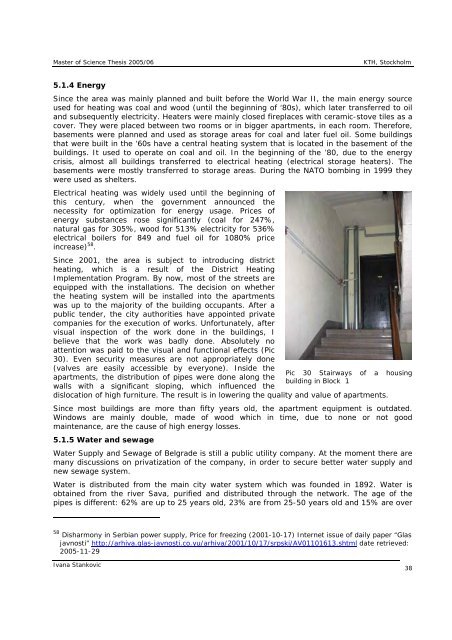Ivana Stankovic
Ivana Stankovic
Ivana Stankovic
Create successful ePaper yourself
Turn your PDF publications into a flip-book with our unique Google optimized e-Paper software.
Master of Science Thesis 2005/06<br />
KTH, Stockholm<br />
5.1.4 Energy<br />
Since the area was mainly planned and built before the World War II, the main energy source<br />
used for heating was coal and wood (until the beginning of ‘80s), which later transferred to oil<br />
and subsequently electricity. Heaters were mainly closed fireplaces with ceramic-stove tiles as a<br />
cover. They were placed between two rooms or in bigger apartments, in each room. Therefore,<br />
basements were planned and used as storage areas for coal and later fuel oil. Some buildings<br />
that were built in the ‘60s have a central heating system that is located in the basement of the<br />
buildings. It used to operate on coal and oil. In the beginning of the ’80, due to the energy<br />
crisis, almost all buildings transferred to electrical heating (electrical storage heaters). The<br />
basements were mostly transferred to storage areas. During the NATO bombing in 1999 they<br />
were used as shelters.<br />
Electrical heating was widely used until the beginning of<br />
this century, when the government announced the<br />
necessity for optimization for energy usage. Prices of<br />
energy substances rose significantly (coal for 247%,<br />
natural gas for 305%, wood for 513% electricity for 536%<br />
electrical boilers for 849 and fuel oil for 1080% price<br />
increase) 58 .<br />
Since 2001, the area is subject to introducing district<br />
heating, which is a result of the District Heating<br />
Implementation Program. By now, most of the streets are<br />
equipped with the installations. The decision on whether<br />
the heating system will be installed into the apartments<br />
was up to the majority of the building occupants. After a<br />
public tender, the city authorities have appointed private<br />
companies for the execution of works. Unfortunately, after<br />
visual inspection of the work done in the buildings, I<br />
believe that the work was badly done. Absolutely no<br />
attention was paid to the visual and functional effects (Pic<br />
30). Even security measures are not appropriately done<br />
(valves are easily accessible by everyone). Inside the<br />
Pic 30 Stairways of a housing<br />
apartments, the distribution of pipes were done along the<br />
building in Block 1<br />
walls with a significant sloping, which influenced the<br />
dislocation of high furniture. The result is in lowering the quality and value of apartments.<br />
Since most buildings are more than fifty years old, the apartment equipment is outdated.<br />
Windows are mainly double, made of wood which in time, due to none or not good<br />
maintenance, are the cause of high energy losses.<br />
5.1.5 Water and sewage<br />
Water Supply and Sewage of Belgrade is still a public utility company. At the moment there are<br />
many discussions on privatization of the company, in order to secure better water supply and<br />
new sewage system.<br />
Water is distributed from the main city water system which was founded in 1892. Water is<br />
obtained from the river Sava, purified and distributed through the network. The age of the<br />
pipes is different: 62% are up to 25 years old, 23% are from 25-50 years old and 15% are over<br />
58 Disharmony in Serbian power supply, Price for freezing (2001-10-17) Internet issue of daily paper “Glas<br />
javnosti” http://arhiva.glas-javnosti.co.yu/arhiva/2001/10/17/srpski/AV01101613.shtml date retrieved:<br />
2005-11-29<br />
<strong>Ivana</strong> <strong>Stankovic</strong><br />
38
















